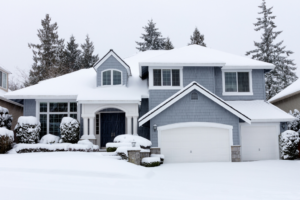Winterizing your home to protect against snow and below-freezing temps can help your home withstand the ups, downs and erratic moods of Mother Nature.
Tips to prepare the inside of your home for winter

The comforts of a cozy, warm home in winter can help you forget about the short days and the multiple layers of clothing. These tips can help you weather the winter season.
- Have your furnace inspected. Since your heating system will probably be running constantly throughout the winter, you should have it inspected annually to help it run efficiently and prevent CO from entering your home. Also remember to change out your HVAC filters every month.
- Inspect the insulation in your attic and crawlspaces. Warm air rises and leaves the house through the roof, so you should focus on insulation in your ceilings. Insulating the crawlspaces will help keep your floors warm.
- Seal potential leaks. Before cold weather comes, take time to insulate your home or apartment to keep the winter chill outside. Seal areas around recessed lights, the attic hatch and plumbing vents that may be allowing warm air from the living space below to enter the attic.
- Allow for ventilation. Proper attic ventilation, adequate attic insulation and a tight air barrier between the attic and the interior of the house will work together to prevent ice dams.
- Use window sheet kits. If you don’t have double-paned or storm windows pick up a plastic-film sheet kit from your local hardware store. These will only last one season, but they do help with energy efficiency and are able to halt the cold flow of winter drafts. Try these updates to help make windows energy efficient:
- Install storm windows,
- Hang curtains,
- Add caulk to windows,
- Use weather stripping,
- Create exterior shade, and
- Replace your windows.
 Apply weather stripping. Add weather stripping to doors and caulk window gaps. Make sure all windows are locked to keep out as much cold air as possible.
Apply weather stripping. Add weather stripping to doors and caulk window gaps. Make sure all windows are locked to keep out as much cold air as possible.- Use a fireplace. If you plan to use it, schedule an inspection and service by a professional to make sure your chimney is clear of debris and that your damper opens, closes and seals tightly.
- Insulate pipes. Pipes located in attics, crawl spaces, basements and near outer walls can be susceptible to freezing in extreme temperatures. Insulate to help prevent your pipes from freezing. When the forecast calls for unusually cold temperatures:
- Let water drip from hot and cold faucets overnight.
- Keep cabinet doors open to allow warm air to circulate in places like below sinks. If you open the cabinet doors, be sure to remove anything inside the cabinets that may pose a safety to hazard to children, such as household cleaners.
- Finally, consult your local utility company about an energy assessment to determine where your home is losing energy and what energy-smart investments would make sense.
Tip: Smart home apps and amenities, such as a smart thermostat, can help you integrate winter management of your home into your everyday routine, helping you to trim energy costs and keep your home cozy too. Winterizing can help you enjoy indoor days, knowing you’ve done what you can to protect your living space through the season and aid in the overall maintenance and longevity of your home.
Winterizing Your Home Tip From Kintner Modular Homes.
source; https://www.statefarm.com/simple-insights/residence/winterizing-your-home
